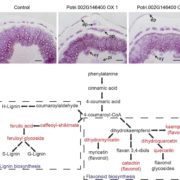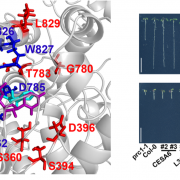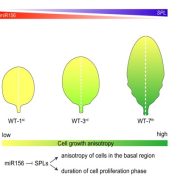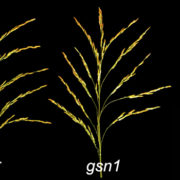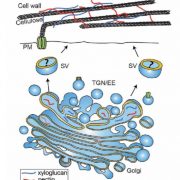Lights, camera, pectin: Bringing hypocotyl elongation out of the dark
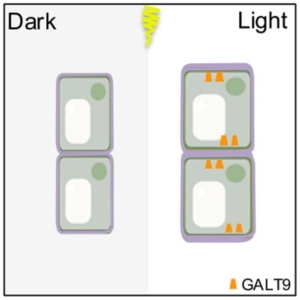 Light is a powerful signal, shaping plant development and growth. However, the cellular mechanisms that translate light signals into precise developmental responses are still being unravelled. The Arabidopsis hypocotyl (the embryonic stem, situated underneath the cotyledons in seedlings) rapidly restricts elongation upon light exposure. Zhang et al. combined molecular and mechanical techniques to uncover a succinct model for how this inhibition occurs in the dark-to-light transition. Initially, using time-lapse photography, they identified a key regulator inhibiting hypocotyl elongation: ELONGATED HYPOCOTYL 5 (HY5). Through chemical quantification and immunohistochemical analysis of the cell walls they found that, unlike in wild-type plants, there is no change in the accumulation of pectin in the hy5 mutant. Further, Raman microscopy showed that pectin is polarised to transverse walls of cells following light treatment – a pattern absent in hy5. This polarisation of pectin is due to the asymmetric localisation of GALACTOTRANSFERASE9 (GALT9) to the transverse cell walls. GALT9 is upregulated in the absence of miR775 – which is suppressed by stabilized HY5. This polarisation of pectin increases the elastic modulus (measured using Atomic Force Microscopy) of transverse cell walls in a wild-type system in response to light, therefore inhibiting elongation of the hypocotyl. These results offer new mechanical insight into the inhibition of hypocotyl growth in response to light, unveiling pectin and GALT9 as key players in this process. (Summary by Kes Maio @kesmaio.bsky.social) Curr. Biol. 10.1016/j.cub.2024.12.026
Light is a powerful signal, shaping plant development and growth. However, the cellular mechanisms that translate light signals into precise developmental responses are still being unravelled. The Arabidopsis hypocotyl (the embryonic stem, situated underneath the cotyledons in seedlings) rapidly restricts elongation upon light exposure. Zhang et al. combined molecular and mechanical techniques to uncover a succinct model for how this inhibition occurs in the dark-to-light transition. Initially, using time-lapse photography, they identified a key regulator inhibiting hypocotyl elongation: ELONGATED HYPOCOTYL 5 (HY5). Through chemical quantification and immunohistochemical analysis of the cell walls they found that, unlike in wild-type plants, there is no change in the accumulation of pectin in the hy5 mutant. Further, Raman microscopy showed that pectin is polarised to transverse walls of cells following light treatment – a pattern absent in hy5. This polarisation of pectin is due to the asymmetric localisation of GALACTOTRANSFERASE9 (GALT9) to the transverse cell walls. GALT9 is upregulated in the absence of miR775 – which is suppressed by stabilized HY5. This polarisation of pectin increases the elastic modulus (measured using Atomic Force Microscopy) of transverse cell walls in a wild-type system in response to light, therefore inhibiting elongation of the hypocotyl. These results offer new mechanical insight into the inhibition of hypocotyl growth in response to light, unveiling pectin and GALT9 as key players in this process. (Summary by Kes Maio @kesmaio.bsky.social) Curr. Biol. 10.1016/j.cub.2024.12.026


